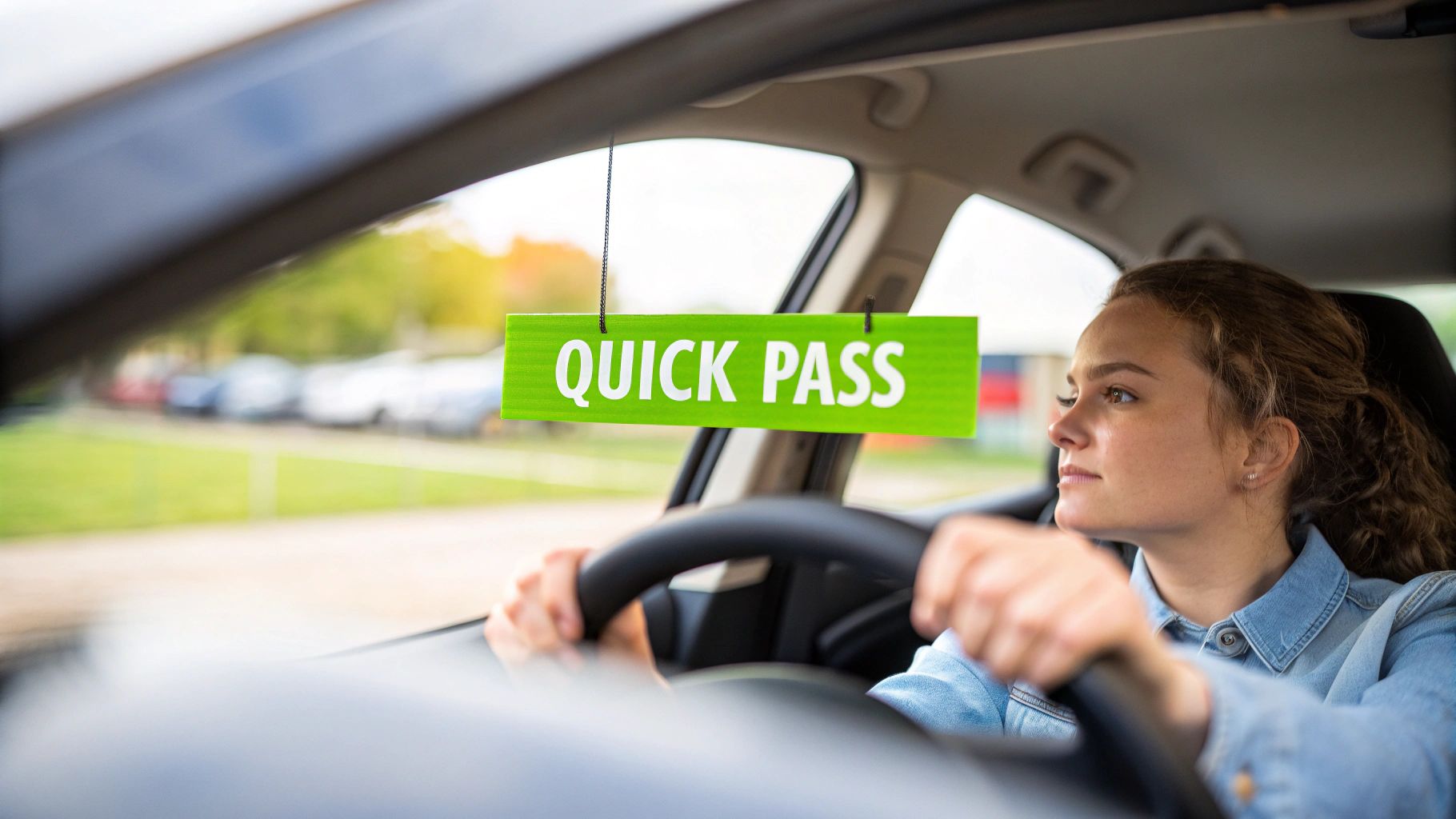Passing your driving test quickly isn't about luck. It all comes down to a smart formula: strategic preparation, intensive practice, and clever booking tactics. It’s about building a focused plan that covers every angle, from nailing your manoeuvres to sniffing out an early test date.
Your Fast-Track Plan to Passing the Driving Test
Feeling the urgency to get your licence? You're definitely not the only one. So many learners want to figure out how to pass their driving test quickly, and the good news is that it’s completely doable with the right strategy.
Forget about cutting corners. This is about working smarter, not harder. The traditional, slow-drip approach of one lesson a week just drags the process out for months. The real secret is to switch to a more focused mindset from the very beginning. By condensing your learning, you build momentum and keep those fresh skills sharp, avoiding that frustrating feeling of forgetting half of what you learned last week.
Laying the Groundwork for Speed
The very first steps you take are what set the pace for everything that follows. Before you even think about getting behind the wheel, get your admin sorted. That means having your provisional licence in hand and your theory test already passed. Waiting for these documents is a classic, and totally avoidable, delay.
This infographic lays out the essential first moves for a flying start.
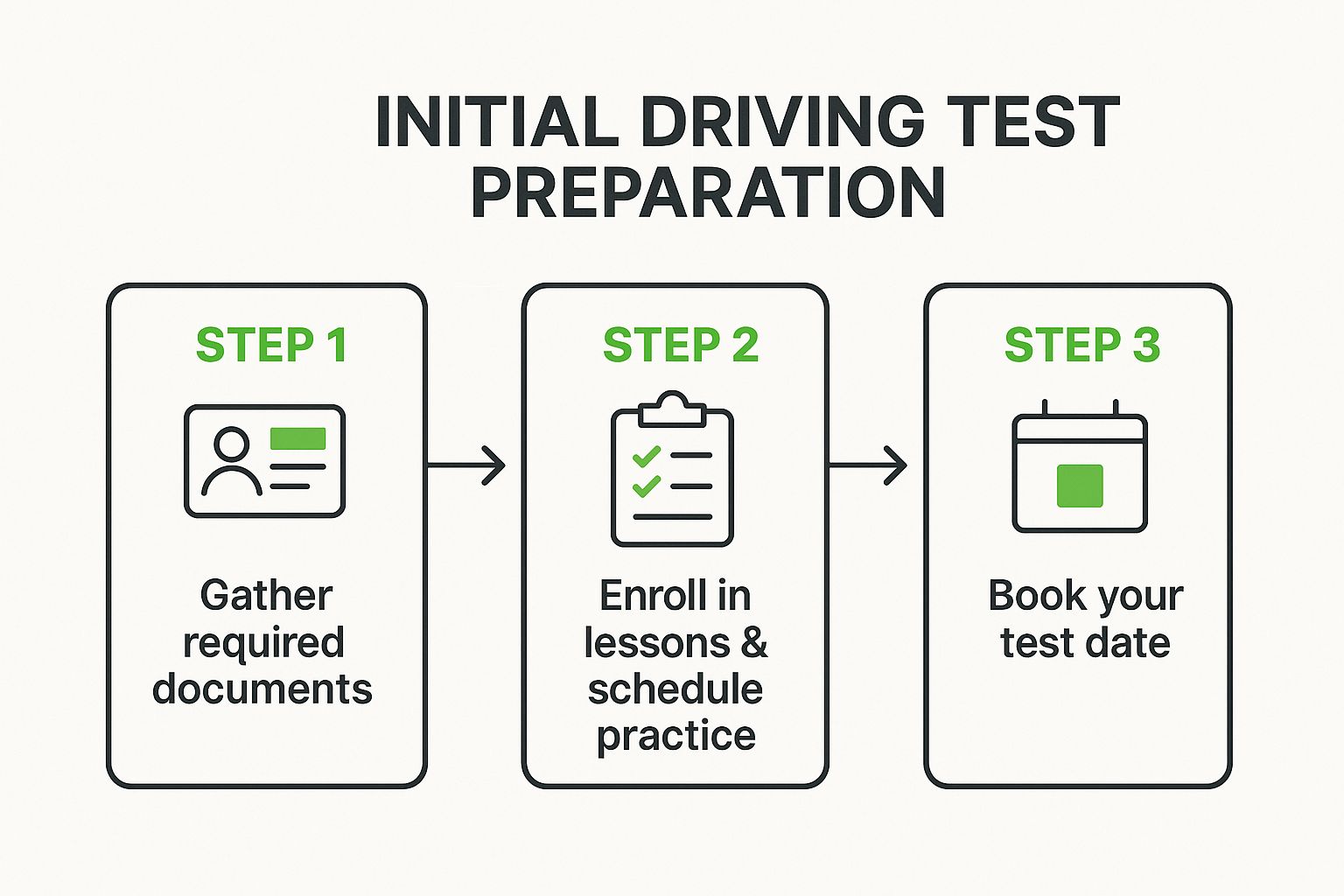
The flow is simple but powerful: get your paperwork in order, then immediately line up your lessons and book your practical test. Having that firm deadline gives you a real sense of purpose and direction.
The Power of an Intensive Schedule
One of the most effective ways to speed things up is to book a structured course. Instead of one-hour lessons dotted weeks apart, you get a solid block of training delivered over just a few days or weeks. This method works wonders.
- You actually remember things. What you learned yesterday is still fresh, not a distant memory from last Tuesday.
- Your confidence soars. Being in the car consistently helps you get comfortable with tricky junctions and roundabouts much faster.
- Your instructor is locked in. They can build a lesson plan laser-focused on getting you ready for that specific test date.
The biggest win from a focused schedule is the momentum. When you’re driving every day, the car starts to feel like an extension of you—and that's exactly the kind of natural confidence examiners look for.
It's interesting to note that while fewer tests are being conducted, more learners are actually passing. The practical driving test pass rate recently hit 49% in March of one year, a decent jump from 46.9% the previous March. This tells us that the people who get to test day are better prepared, likely because they've used focused training methods.
To help you map out your own journey, here’s a quick overview of the strategies we've been discussing.
Quick Pass Strategy Overview
| Strategy Area | Key Action | Why It Speeds Up the Process |
|---|---|---|
| Preparation | Get your provisional licence and pass your theory test before booking lessons. | Eliminates the most common administrative delays right from the start. |
| Learning Structure | Choose an intensive or semi-intensive course over weekly lessons. | Condenses learning, improves skill retention, and builds confidence rapidly. |
| Booking Tactics | Book your practical test early to set a clear deadline and goal. | Creates commitment and allows you to find cancellations for an even earlier date. |
| Practice | Focus on test routes and weak spots in the days leading up to your test. | Ensures your practice is targeted and relevant to what the examiner will assess. |
This table neatly summarises how to get from L-plates to a full licence without the usual long delays.
If you're serious about getting on the road sooner rather than later, diving into a structured plan is your best bet. A great place to start is by looking into intensive driving courses, which provide a clear roadmap to success.
Laying the Groundwork for a Fast Pass
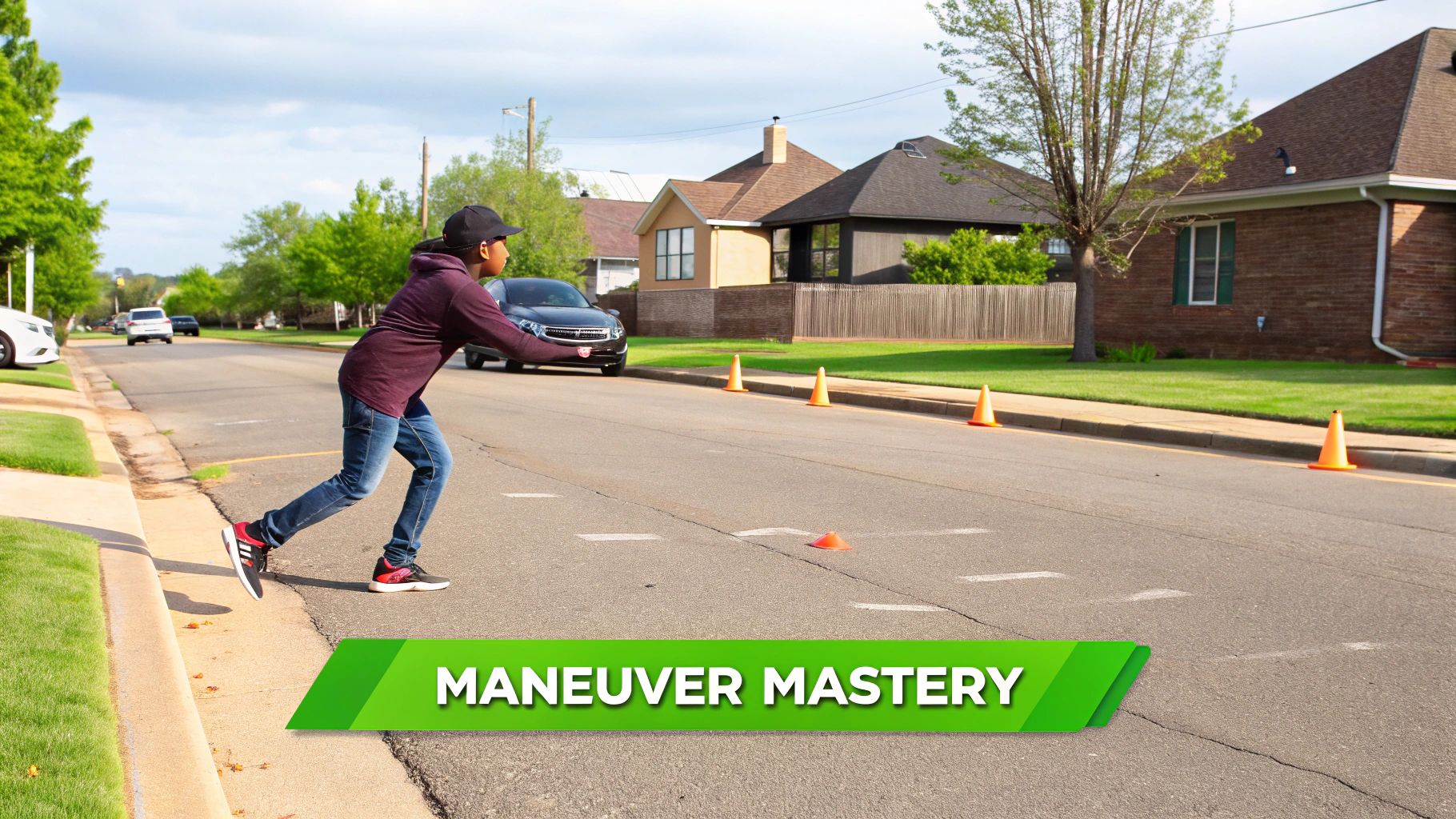
Before you even think about booking a lesson, let alone a test date, you need to get the basics sorted. Trying to rush your driving test without this prep work is a recipe for failure; your skills just won't stand up to the pressure on the day. Everything hinges on getting these first few steps right.
First things first: get your provisional licence. It sounds incredibly obvious, but you’d be surprised how many people delay this and then spend weeks twiddling their thumbs, waiting for it to arrive. Apply for it the moment you’re eligible so it's ready to go when you are.
At the same time, you need to be hitting the theory books—hard. You physically cannot book a practical test until you have that theory pass certificate in your hand. My advice is to get it passed before you even start your lessons, or at the very least, while you're taking your first few. Getting this major hurdle out of the way early means you can pour all your energy into the actual driving.
Finding the Right Instructor and Lesson Plan
The instructor you choose and how you structure your lessons will completely define how quickly you learn. A single, one-hour lesson each week is the slow route. You end up forgetting half of what you learned by the next session, and it can drag the process out for months.
If you’re serious about passing quickly, look into a reputable professional driving school that offers more focused courses. You're looking for an instructor who gets what you're trying to do and can build a plan that matches your ambitious timeline.
Don't be shy about interviewing potential instructors. Ask them about their pass rates, especially for intensive courses. A good instructor should feel like a coach who’s genuinely invested in getting you that pass certificate, fast.
This brings us to how you should actually learn. The two magic words are consistency and intensity. Think about the difference here:
- Weekly Lessons: You spend the first 15 minutes just remembering what you did last week. Progress feels slow and fragmented.
- Intensive Blocks: You're behind the wheel for a few hours at a time, often on consecutive days. Skills build on each other, muscle memory kicks in, and your confidence skyrockets because you're constantly immersed.
An intensive schedule keeps you in the 'driving zone'. Tricky roundabouts, complex junctions, and all those manoeuvres become second nature far more quickly because the learning is compressed. Honestly, it's the most effective way to get test-ready in a short amount of time and build a solid foundation for passing first time.
Nailing the Practical Skills When It Counts
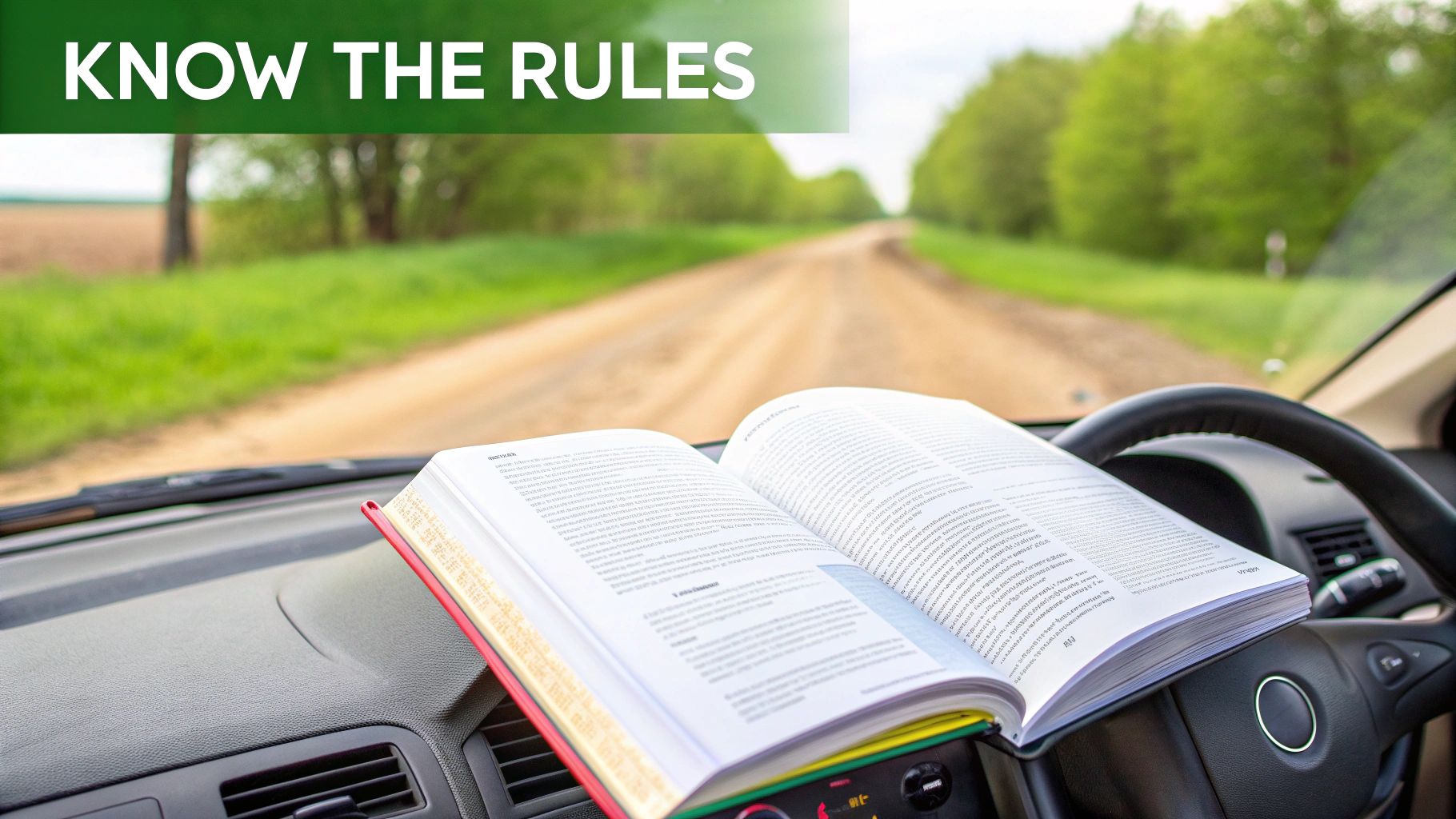
If you're serious about passing your driving test fast, this is where the rubber really meets the road. All the theory in the world won't help if you can't execute flawlessly under the pressure of an examiner watching your every move. It's all about turning what you know into what you can do without a second thought.
This means your practice needs to be laser-focused. Aimless driving around town for hours on end is a slow, expensive way to learn. Instead, every single lesson should have a clear mission. Today, are you going to conquer that three-lane roundabout? Or maybe you'll finally perfect that pesky parallel park. Pinpoint your weaknesses with your instructor and drill them over and over until they feel like second nature.
A structured plan builds muscle memory. A scattered approach just builds frustration.
Make Your Practice Feel Like the Real Deal
One of the most powerful things you can do is to make your lessons feel exactly like the test itself. Get your instructor to run full-blown mock tests. I’m not just talking about the driving part; it’s about getting used to the specific atmosphere of the test.
That means no radio, no casual chit-chat, just you, the road, and instructions from your "examiner." The silence and the feeling of being watched can be really unnerving for a lot of learners. By exposing yourself to it early and often, you'll find the real test day feels much less daunting.
Don't forget the 'independent driving' section. This trips up so many people. Ask your instructor to set a destination on the sat nav or give you a series of road signs to follow. Proving to yourself that you can navigate calmly and correctly is a massive confidence boost.
When you've done a dozen mock tests, the real thing just feels like another practice run. It’s all about taking the fear of the unknown out of the equation.
Become a Master of the Local Test Routes
Driving examiners don't just pull routes out of a hat. They use pre-planned routes designed to test you on a whole range of local road features. Gaining an almost encyclopaedic knowledge of these routes is your biggest unfair advantage.
Your instructor will be your best resource here – they'll have driven these routes hundreds of times. Insist on spending your later lessons covering every inch of them.
- Pinpoint the Trouble Spots: Every test centre has its notoriously awkward junction or confusing roundabout. Find it and drive it until it's boring.
- Know Your Speed Limits: Be hyper-aware of where limits change, especially near schools or on roads that switch from 30 mph to 40 mph without much warning.
- Practise Manoeuvres in Context: Use the quiet side roads and car parks along the actual test routes to polish your parking. Get used to the specific cambers and kerb heights you'll face on the day.
When you're completely familiar with the road layout, the potential hazards, and the general flow of traffic, you free up so much mental bandwidth. Instead of constantly reacting to surprises, you begin to anticipate what's coming next. That's the hallmark of a confident, safe driver—and it's exactly what the examiner is looking for.
The Smart Way to Book Your Driving Test
Once you're feeling confident behind the wheel, you've hit the final administrative hurdle: actually booking your practical test. The long waiting lists across the UK are a notorious source of frustration, so if you want a test date soon, you need a solid game plan. Simply hoping a convenient slot will pop up on the DVSA website is a recipe for a long, slow wait.
The truth is, getting a test booked quickly comes down to being persistent and flexible. New slots and cancellations do get added to the official system around the clock, but they’re often gone in a flash. This leaves you with two real options: relentlessly check the site yourself, or use a service to do the hard work for you.
Manual Checking vs. Cancellation Apps
Going the manual route and checking the DVSA site yourself costs nothing but your time and sanity. It can work, but it demands serious dedication. I've known students who've succeeded this way, but they were checking the website multiple times a day—often first thing in the morning and late at night when system updates seem to happen. It's a numbers game that relies on your own persistence and a healthy dose of luck.
On the flip side, driving test cancellation finders have exploded in popularity, and for good reason. These apps and services constantly scan the DVSA system for you, pinging you with an alert the moment a suitable slot becomes available.
The real benefit of a cancellation service is that it buys you back your time and focus. Instead of spending hours hitting refresh on a webpage, you can concentrate on your driving practice, confident that the search is being handled in the background.
Most of these services charge a small fee, but many learners see it as a worthwhile investment to skip a wait that could otherwise stretch for months. In effect, they let you jump the queue by nabbing a test date someone else has just cancelled. If you want to dig deeper, you can learn more about fast-track driving test booking services to see if it’s the right move for you.
Broaden Your Horizons for Faster Results
One of the best tactics for finding a test quickly is to be flexible about where you take it. If you're based in a major city, your local test centres will almost certainly have the longest waiting lists.
Try expanding your search to include test centres in smaller towns nearby. A 30-minute drive to a different location could easily slash weeks, or even months, off your waiting time.
Of course, this strategy requires a bit of extra effort:
- You'll need to practise there: It’s vital to have at least a couple of lessons in the new area. You need to get to know its unique roundabouts, tricky junctions, and local hazards.
- Logistics are key: You have to be certain you can get to the alternative test centre reliably on the day of your test.
Still, if your main goal is to pass your driving test quickly, combining a cancellation finder with a willingness to travel to different test centres is your most powerful strategy. It shifts the odds firmly in your favour, turning a game of chance into a proactive plan.
Navigating Test Day for a First-Time Pass
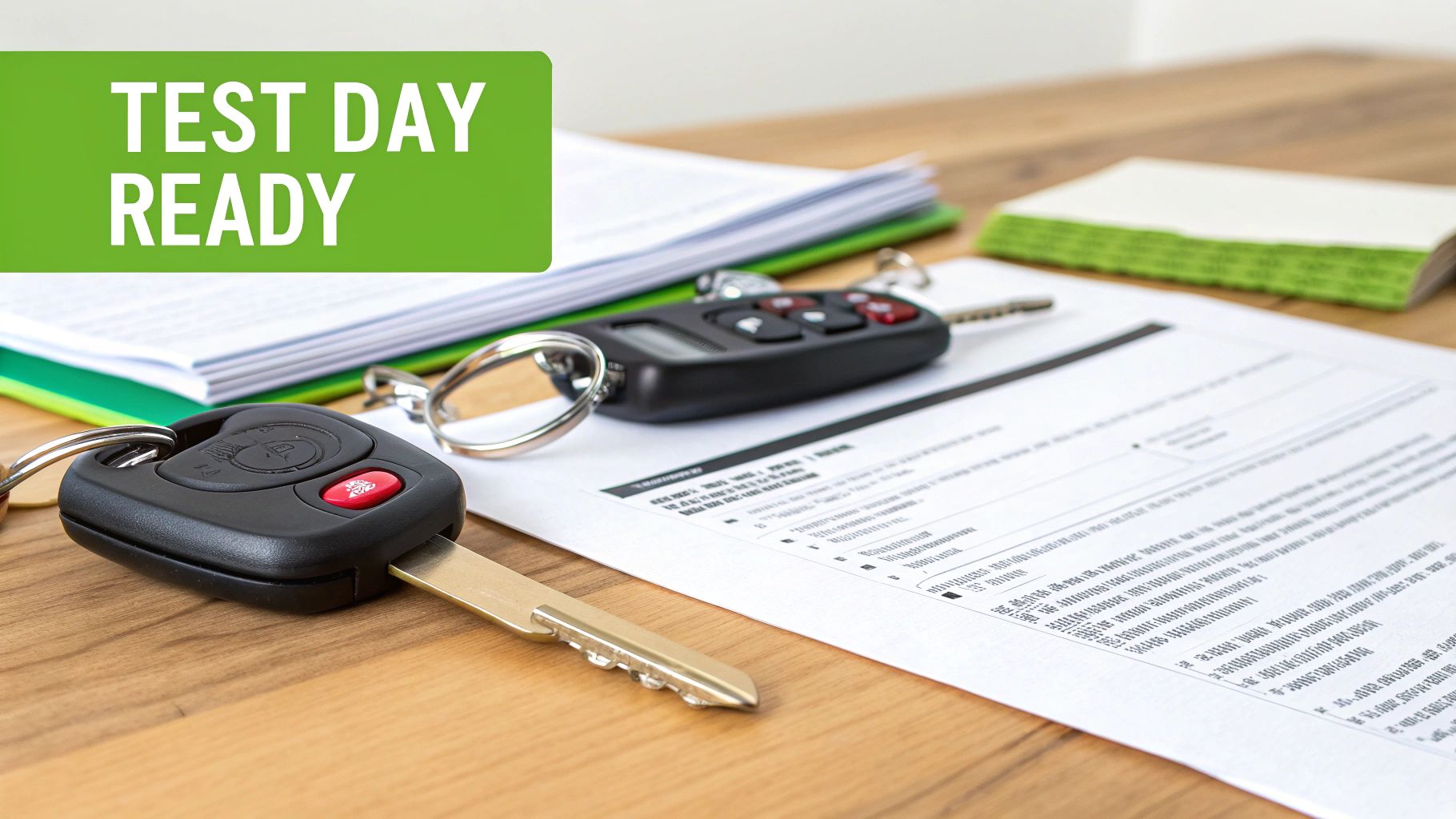
This is it. After all the hours of practice and preparation, test day is your chance to prove you’re a safe, competent, and confident driver. It's not about being flawless; it’s about showing the examiner you can handle the car and make sensible decisions, even with a few nerves thrown in.
The test really starts before you even turn the key. Those 'show me, tell me' questions are your first opportunity to create a good impression. Your instructor will have gone over these with you endlessly, so take a breath and answer clearly. You’ll get one question before you set off and another while you’re on the move. Getting one wrong won’t fail you on the spot, but getting them right shows you’ve come prepared.
The Right Mindset is Half the Battle
On test day, your composure is your most valuable asset. So many capable learners fail not because they lack skill, but because one small mistake snowballs into a full-blown panic. Remember, the examiner isn’t expecting a robot. They're looking for a safe human driver who can manage the real-world pressures of the road.
If you make a minor error, like stalling the car at a busy junction, it's not the end of the world. What truly matters is how you handle it.
- Breathe: Don't let your heart race. Just pause for a second.
- Secure: Handbrake on. Put the car in neutral.
- Restart & Check: Start the engine and do your full observations before moving off safely.
A calm, controlled recovery from a small mistake is far more impressive to an examiner than a flustered, panicked reaction. They’ll likely just mark it as a minor driving fault and move on. It’s your ability to stay cool under pressure that’s really being tested.
What Examiners Actually Want to See
Examiners are trained to evaluate one thing above all else: your overall safety. They need to see you consistently checking mirrors before changing speed or direction, scanning the road ahead, and anticipating what other road users might do next. A perfect parallel park is great, but doing it while remaining fully aware of a passing cyclist is what really counts.
This is especially true during the independent driving portion, which takes up around 20 minutes of your test. Whether you're following a sat nav or traffic signs, the aim is to see if you can drive safely and make your own decisions. If you miss a turn, don’t panic! This isn’t a navigation exam. As long as you take the wrong turn safely and legally, you won't get a fault. Just keep driving until the examiner guides you back on track.
It’s worth remembering that passing is well within reach for anyone who has prepared properly. Even with nearly 1.93 million tests conducted annually in recent years, the pass rate holds steady at about 48%. This tells us that solid preparation, not luck, is the deciding factor. You can dig into more detailed figures by checking out the UK driving test statistics on RAC.co.uk.
Ultimately, if you can show you’re observant, proactive, and in control, you’re giving yourself the best possible shot. Try to see the test not as a scary exam, but as just another drive where you get to show off the safe skills you've spent so much time building.
Frequently Asked Questions About Passing Quickly
Even with the best plan in the world, you're bound to have a few questions when trying to get your licence in a hurry. Let's run through some of the most common queries we hear from learners. Getting these cleared up will give you the confidence to push forward.
Can I Really Pass in Just One Week?
This is the big one, isn't it? The dream of going from learner to driver in just a few days. And honestly, for some people, it's absolutely possible. If you’ve already got a good amount of driving under your belt—maybe you had lessons years ago or you've driven a lot overseas—a one-week intensive course could be the perfect final push you need to get test-ready.
But for a complete beginner, starting from scratch? A week is a very tall order. Learning to drive isn't just about mastering the manoeuvres. It's about developing that gut feeling for the road, the kind of awareness that only builds with experience. For a brand new driver, a more realistic (but still very fast!) timeframe is usually two to four weeks of solid, intensive practice.
What if I Fail My First Test?
It happens, and it feels rubbish. But the absolute worst thing you can do is let it knock you off course. If you wait too long to get back in the car, doubt starts to set in and those sharp skills you just built can go rusty.
Think of a fail not as a step back, but as incredibly specific feedback. Your examiner's report is a gift—it's a literal checklist of what to polish. Book a couple more hours with your instructor straight away and drill down on those exact points.
Try to see the upside: you've now been through the whole test process once. The mystery is gone, and the nerves won't be nearly as bad the second time. If you need a bit more of a game plan, there’s some great advice on what to do after failing your driving test to help you bounce back stronger.
Does My Age Affect How Quickly I Can Pass?
It's a fair question, and the stats do show some interesting trends. Younger learners definitely tend to get the hang of it a bit quicker. For instance, recent UK data shows a pass rate of around 61.33% for 16-year-olds, and it stays pretty high for 17-year-olds before starting a slow, steady decline as age increases.
This doesn't mean older learners can't pass quickly! It just means younger drivers often learn during school holidays, with fewer distractions like work or family commitments, allowing them to really immerse themselves. Older learners can absolutely match this pace by booking an intensive course and clearing their schedule. Ultimately, it all comes down to focused, consistent practice, no matter how old you are. It's all about building that confidence and muscle memory an examiner wants to see.
Ready to stop waiting and start driving? At Fast Pass Driving Courses, we specialise in getting you on the road quickly with our structured intensive courses and fast-track test booking service. Find your perfect course and book your test today!

